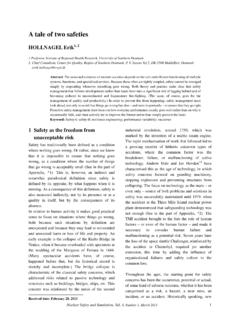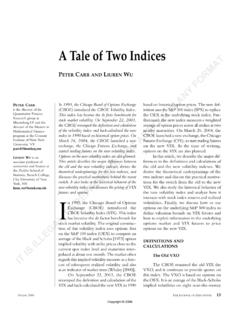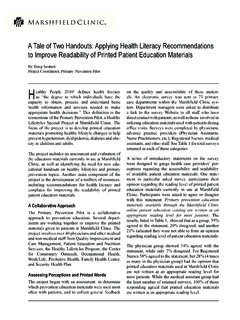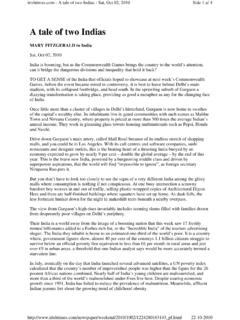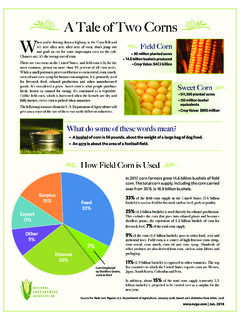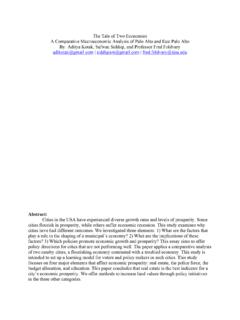Transcription of A Tale of Two Camshafts - St. Louis NCRS
1 A Tale of Two Camshafts by Duke Williams with Dennis Clark, Mike McCagh, and John McRae [Editor s note: This article was originally published in the Fall 2010 Corvette Restorer . This revised edition is presented with the permission of the authors and NCRS.] In the last few years I have completed several vintage Corvette engine system engineering projects. The first two involved a 65 L79 and a 65 L76. The owners wished to maximize power without affecting normal operating behavior or original visual appearance. Using the Engine Analyzer engine simulation program with head flow data provided by the owners, I developed a configuration that I named 327 LT1, which consists of massaged heads, the 1970 LT1 camshaft, and upgraded connecting rods to ensure a bulletproof bottom end. The original rods, particularly the pre- 66 version without the additional material adjacent to the bolt seats, are the 327 s Achilles heel.
2 One engine was tested on a laboratory dynamometer and the other on a Dynojet inertia-type chassis dynamometer approaching 300 SAE corrected rear wheel horsepower at 6500 revs with 80 percent of peak torque at 2000 (which was a primary requirement) 90 percent at 2500, and a useable power bandwidth to 7200. Given the success of these projects, I turned my attention to the 300-horsepower engine, which is the most commonly installed engine of the 1962-68 period. Base 350s from 1969 to 1974 will show similar improvements, but the highly restrictive single catalyst exhaust system beginning in 1975 will mostly negate internal engine flow improvements due to excessively high exhaust backpressure that greatly increases exhaust parasitic pumping power. Engine Performance How many times have I heard guys say, I want more power ?
3 But peak power is only available at the top of the rev range, and we spend percent of our driving time below this range. There s an old expression variously attributed to engineers from both GM and Mercedes Benz: People buy power, but they like torque. How true! An engine with high low-end torque has high low-end power and will feel very responsive in normal driving no waiting for the engine to come on the cam. An excellent comparison within the 327 Corvette engine family is the 300-horsepower version and the 365-horsepower L76. The 327/300 is very pleasant to drive in normal traffic with its docile manners and stump-pulling low-end torque while the 365-horsepower engine is notoriously torque-shy. Granted, the 327/300 fades away beyond 4500 while the 327/365 keeps pulling to the 6500 tachometer redline, but you pay a price in lower fuel economy and busy highway operation due to the shorter required gearing to keep this engine higher in the rev scale at normal driving speeds.
4 Understanding vintage Corvette engine performance begins with realizing that the advertised SAE gross ratings are highly optimistic and little more than advertising copy. Gross torque is somewhat overstated, and power is overstated by up to 20 percent. SAE gross ratings were based on laboratory dynamometer tests of stripped engines: no front-end accessories other than the coolant pump, large exhaust pipes and no mufflers with an evacuation pump that reduces exhaust back pressure below atmospheric, and test data corrected to standard sea level conditions inches Hg. barometric pressure, 59 degrees Fahrenheit, dry air. These correction conditions are also commonly referred to as STP (standard temperature and pressure) and are still the defacto standard for field laboratory dynamometer test correction.
5 Fuel flow and spark advance maps did not have to be the same as production, and flash readings were accepted as real data. Then it was all sent to the marketing guys for more massaging. In recognition of the games manufacturers were playing with the numbers during the halcyon days of the horsepower wars, all agreed to adopt a new SAE net rating system beginning in 1971. That year both gross and net ratings were advertised, but only net from 1972-on. SAE net ratings require the engine to be in the same configuration as installed in the vehicle, which includes production fuel flow and spark advance maps, all front-end accessories, the engine air-induction system, and the full vehicle exhaust system. In addition, observed data are corrected to inches Hg., 77 degrees Fahrenheit, dry air representative of a warm spring day in Chicago, rather than a mild spring day in Seattle.
6 These same conditions also apply when SAE correction is applied to chassis dynamometer data. This lower air density correction alone reduces torque and power by about percent relative to STP conditions. The remaining losses are from front-end accessories and the vehicle exhaust system. Various rules of thumb have appeared over the years to convert SAE gross to SAE net, which are usually in the range of 80 percent, but it varies considerably with the specific installation, and the exhaust system is critical. Most vintage Corvettes are blessed with very efficient exhaust systems. Zora was clearly thinking ahead when the C2 frame was designed to accommodate exhaust pipes through the center cross member. Exhaust systems for many vehicles of that era were little more than afterthoughts, which includes many big block muscle cars, and those restrictive exhaust systems ate up a lot of power between the dynamometer cell and vehicle installation.
7 I have been collecting dynamometer tests of all sorts for many years, and my computed empirical net/gross conversion factor based on these data for 327s with exhaust pipes is , and air density correction alone accounts for 40 percent of the reduction! The 327 LT1 only generates a little over 3 psi backpressure at close to 300 SAE corrected rear wheel horsepower, which is very modest and as good as modern high-performance cars. If the fan clutch does not tighten, its power consumption is small only one to two horsepower but up to 15 pound-feet torque and 10-plus horsepower if it fully tightens. The 1962 model s 2-inch pipes, even with the off road mufflers, are somewhat more restrictive, and Special High Performance big blocks will approach 6 psi due their greater exhaust flow. (Exhaust backpressure increases with the square of flow volume.)
8 Many wonder how much improvement the outlet exhaust manifolds installed on most 327 configurations from 62- 65 yield over the 2-inch outlet versions used on all later small blocks. I don t have enough data to nail it down, but I doubt if the difference is more than one to two percent. Cylinder Heads. As I ve said so many times before, the way to get more power is to massage the cylinder heads work the heads for power and select a camshaft that provides the necessary low-end torque for the type of service. For a high performance road engine with a manual transmission, my target is no less than 80 percent of peak torque at no less than 2000 revs. This is a basic engine system engineering requirement, and for automatic transmissions my requirement increases to 90 percent at 2000, which is at or just above torque converter stall speed for most OE automatics.
9 Anything less and the engine will feel soggy and unresponsive in normal driving environments. Head massaging doesn t mean hogging out the ports to the edge of the cooling jacket passages. Actually, little material needs to be removed. The point is to increase the port flow coefficient, not port cross-section area. Engineers use a concept called isentropic flow that is an easy way to analyze the flow potential of a duct. It ignores such real world complications as heat transfer and friction, but yields simple formulas to compute idealized flow potential. The ratio of actual flow to computed isentropic flow, the flow coefficient, is a measure of the design. As built, OE small block head ports are typically in the to range. The best purpose-built racing heads exceed , and with proper rework a set of OE vintage Corvette cylinder heads can achieve about on the inlet side and about on the exhaust side.
10 The exhaust port has higher flow coefficient potential because it is short and less convoluted than the inlet port, which has to wrap around the pushrod passage, but the exhaust port is more sensitive to the details of hand work and typically shows more flow variation from job to job. The biggest impediment to OE cylinder head flow is the annular ridge that remains from the first valve pocket roughing operation where the machined area meets the as-cast port. Grinding down this ridge to smoothly blend the machined section to the as-cast section is the most critical operation and is generally known as pocket porting. The sides of the combustion chambers should be beveled back to the edge of the cylinder bores, and downstream overhang at all inlet and exhaust port junctions should be ground away.


